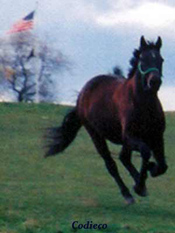
Horse Slaughter
Horse Cruelty
Horse Rescue
Horse Transport
Legislation
Stolen Horses
Press
General
SiteIndex
Double Deck Trailers
- Bottom Deck
- Doghouse
- Nose Deck
- Top Deck
Transport Company Safety Records
State Transport Laws
AZ Law
CA Law
CT Law 1976
MA Law 1977
MD Law 2006
MN Law 1983
NY Law 1980
PA Law 2001
RI Law 2008
VA Law 1987
VT Law
PA Horse Transport Law Cards
Transport Related Violations
PSP Enforcement at New Holland
Federal Law
Commercial Transportation of Horses to Slaughter
Proposed Legislation
IN Horse Transport Law SB86
EPN Testimony
Links
California Voters "Just Say Neigh" to Horse Slaughter!
HoofPAC
Shop online at IGive.com with over 400 great stores you know & love- including Back In the Saddle! Up to 26% of the purchase price is donated to the EPN!
The EPN gets $5 extra the first time you shop!
PayPal accepts credit cards! Please send your tax deductible donation to the:Equine Protection Network, Inc.,
P. O. Box 232, Friedensburg, PA, 17933.
Shop for CD's at CDRush.com & the EPN Benefits!
Put "EPN" in the Coupon Code box when you place your order.
Now you can save money on your favorite music and help the horses at the same time!
HoofPAC is the political action committee that has been formed to end the slaughter of America's horses. Cathleen Doyle, founder of HoofPAC, led the successful Save The Horses campaign in 1998 that made the slaughter of California's horses a felony.

CONNECTICUT STATUTES
Sec. 22-415. Inhumane Transportation of Equines
Any person who carries or causes to be carried or has the care of any equine in or attached to any vehicle or otherwise in an unnecessarily cruel or inhumane manner, or in a way and manner which might endanger the equine or knowingly and wilfully authorizes or permits such equine to be subjected to unnecessary torture, suffering or cruelty of any kind in the transporting of such equine, shall be punished by a fine of not less than one hundred dollars nor more than five hundred dollars. The Commissioner of Agriculture shall adopt regulations pursuant to chapter 54 pertaining to the transportation of equines upon the highways of Connecticut as deemed necessary to prevent the cruel or inhumane treatment of equines.
(P.A. 75-589, S. 2, 3.) Cited. 218 C. 757, 765.REGULATIONS OF CONNECTICUT STATE AGENCIES
22-415-1. Definitions
(a) The following terms are defined as follows:
(1) Horse means all members of the equine family.
(2) Vehicle means any machine, tractor, trailer or semitrailer, or any combination thereof propelled or drawn by mechanical power and used upon the highways in the transportation of property.
(3) Double Deck or Possum Belly means vehicles with two or more levels on which horses can be loaded.
(Effective December 8, 1976)
22-415-2. Prohibitions and Enforcement
(a) No person shall transport horses in any vehicle for more than eighteen (18) hours unless: (1) within such vehicle the horses have enough space and opportunity for rest and are supplied with proper food and drink; or (2) the horses are unloaded for at least five (5) consecutive hours unless prevented by storm or accidental cause. (b) Horses unloaded pursuant to (a) (2) shall be properly fed, watered and sheltered during the time they are unloaded by the owner or person having custody during transportation. (c) Any duly authorized police officer or humane agent may feed, water and shelter horses which are neglected by the owner or person having custody during transportation; such feeding, watering or sheltering shall be at the expense of the owner or person having custody during transportation. (d) The use of double deck or possum belly vehicles to transport horses is strictly prohibited,unless the same is used pursuant to Sec. 22-415-3. (Effective December 8, 1976)22-415-3. Construction and dimensions of vehicles
Any vehicle for the transportation of equines shall meet the following standards:
(1) The interiors of compartment containing horses are to be of smooth construction with no protruding or sharp objects.
(2) The floors are to be of non-skid construction or a non-skid material is to be placed on the floor. A nonskid floor shall mean:
(a) Non-skid rubber or like material secured to the floor; or
(b) A reasonable amount of abrasive material - these materials shall include but are not limited to sand, clay, sawdust; or
(c) Metal grade floors with dull surfaces not to protrude or injure hooves but with sufficient base to prohibit sliding.
(3) There shall be adequate ventilation in all closed trailers. Any truck having a slatted body shall be deemed to have sufficient ventilation.
(4) Sturdy partitions are to be provided approximately every ten (10) feet inside the vehicle.
(5) Doorways used by horses are to be of adequate height to allow twelve (12) inches above the withers and to allow the largest horse to pass through without injury.
(6) A minimum of twelve (12) inches must be allowed between the withers of the largest horse and the structure above the horse while the horse is in a natural standing position.
(7) If the vertical distance from the trailer to the unloading area is greater than eighteen (18) inches, ramps for loading and unloading are to be provided and are to be constructed such that they provide safe footing for horses.
(Effective December 8, 1976)
22-415-4. Other restrictions
(a) Injured or handicapped horses shall not be loaded in the same compartment with healthy horses.
(b) Ponies or young horses shall not be loaded in the same compartment with larger and mature horses except as provided in (c) below.
(c) Dams with their own and other sucklings shall be transported in the same compartment and separate from other horses.
(Effective December 8, 1976)
Horse Transport Law Cards
PA
Horse Transport Law Cards | NY
Horse Transport Law Card | Rhode Island Horse Transport Law
Card |
Vermont
Horse Transport Law Card |MA Horse Transport Law Cards | MD
Horse Transport Law Card
Download a card
and carry in your car.
Help enforce PA, NY, RI, MA, MD, & VT Horse
Transport Laws
banning the use
of double deck trailers to transport any
horse,
no matter what its final destination!
You will need Adobe Reader a free plug in that you
can download. ![]()
This is a double deck slatside trailer used to transport horses to slaughter. The truck in the above photo is a brown International cabover with a sleeper.The truck in the photo below is a purple conventional with a sleeper. This IS a double decker cattle and hog trailer, also known as a 'possum belly or'pot' because the section of the trailer between the rear axles of the trailer and the "fifth wheel or nosedeck" section of the trailer is lower to the ground than the rest of the trailer.
A possum belly trailer is similiar to a moving van such as, "MayFlower", "Bekins".
A straight deck trailer is similar to the freight trailers seen on the highway such as, Wal-Mart, JB Hunt, RoadWay.
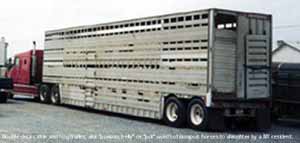 |
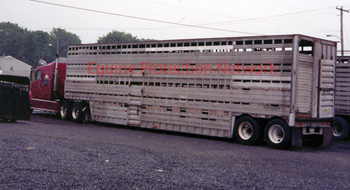 |
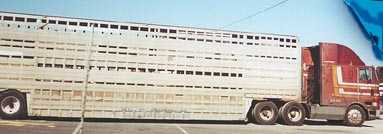 |
The trailer pictured BELOW, is a straight deck SINGLE tier trailer.
This is NOT a double decker,"possum belly" or "pot".
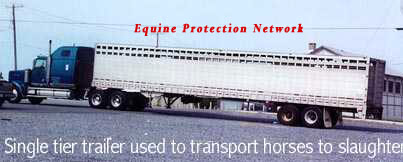
This is a single tier trailer used to transport horses to slaughter. The truck is a Western Star conventional with a sleeper.
This is NOT a double decker or a "possum belly".
Save America's Horses! |
|||||||
|
Please send your tax deductible donation to: Equine Protection Network, Inc., P. O. Box 232, Friedensburg, PA, 17933 |
||
|
Photos On This Page CANNOT be Used Without Written Permission |
||

